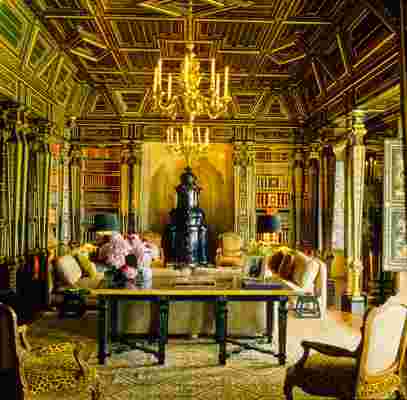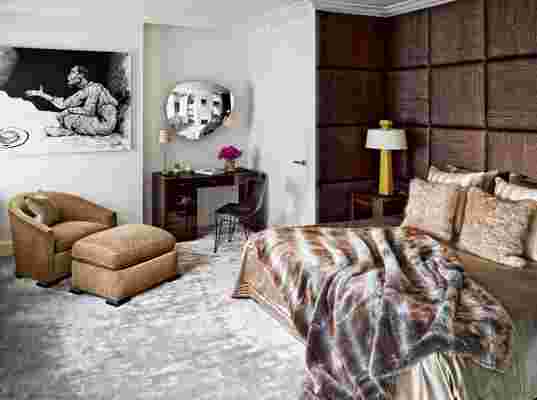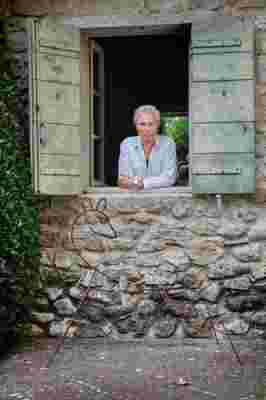Remembering Designer François Catroux, Master of “Grand Coziness”
François Catroux “did things that were truly modernistic before anybody else did,” the Marquise de Ravenel told Vanity Fair a few years ago about the French interior decorator and AD100 Hall of Fame honoree, who died in Paris on Sunday, at the age of 83. “He used materials like stainless steel, plastic, and bronze that were not fashionable then. He was very ahead of his time.”
Catroux’s coveted style, which encompassed not only electrifying contemporary gestures but also sumptuous traditional takes that client Diane von Furstenberg described as “grand coziness,” grew out of his early career scouting interiors for magazine articles. His was a seasoned journalistic eye, seeking out the new while, at the same time, subconsciously honing his own aesthetic vision, a catholic approach which admitted the most rigorous metal mantel as it did a magnificent piece of André Boulle furniture from the 17th century or a Senufo bird sculpture. As the self-taught designer told a newspaper reporter on a visit to New York City in 1970, “I am just resting and observing but of course careful observing is a kind of work.”

The Portuguese country home Quinta Patino, designed by Francois Catroux, includes a library with 17th century coffered-ceiling.
A grandson of a legendary French general and statesman, François Philippe Catroux was born in Algeria in 1936, as was Yves Saint Laurent, his childhood schoolmate turned great friend. Neither the military nor managing the family estates, as his father did, interested him much, but the shaping of environments always did. “When I was five, I was already changing the decoration of my room,” he told James Reginato in a 2016 profile for Vanity Fair, on the occasion of a self-titled Rizzoli monograph that was written by the designer and journalist David Netto. “When my parents were away, I would move the furniture around in the house.” It was a habit that would eventually launch Catroux’s career, largely through necessity. Though he grew up in considerable comfort—his paternal grandmother, a daughter of the former mayor of Mascara, Algeria, inherited extensive real estate in the country—when the Algerian War broke out in the 1950s, the family fortunes took a hit. “I was a playboy who never planned to work,” the designer recalled, “but now I needed to earn a living.”
Tall, lean, dashing, and genial, he was a star from the moment that his first project, a Milan showroom for the fashion designer Mila Schön, was published in 1968. “It looks like tomorrow,” a newspaper report enthused, “all space and almost no furniture.” For those who questioned Catroux’s total lack of experience, he, ever pacific in temperament, simply shrugged. “Training would ruin what I have,” he said in a 1988 interview. “I believe much more in spontaneity. I hate the word taste—it is easy to get from magazines. More important than taste is flair, something you know already. If I had only taste, I would never have dared to do the palazzo for Schön.”

The main suite of a London family’s art-filled town house, which is distinguished by a leather-paneled niche, features a François Catroux–designed desk and a lounge chair and ottoman upholstered in a J. Robert Scott fabric; the work on canvas is by Tim Rollins and K.O.S., the mirror is by Nigel Coates, and the carpeting is by Tai Ping.
The international fête set swiftly flocked to Catroux’s side. Many of those early clients were already part of his social circle, such as art dealer Aimé Maeght, industrialist Antenor Patiño, Marie-Hélène and Guy de Rothschild, and Marie-Hélène’s brother, Thierry van Zuylen, and his wife, Gaby. In the United States, Catroux was tapped by Jan and Gardner Cowles Jr., the Look magazine publisher, for their Manhattan residence at 4 East 66th Street, which had been remodeled by Brutalist architect Paul Rudolph. The Île Saint-Louis apartment that the newlywed Catroux decorated in 1968 for himself and his wife, Betty Saint, a former Chanel model and future Saint Laurent muse, was mind-blowingly futuristic. The salon’s chimney breast was floor-to-ceiling stainless steel, undulating sofas and banquettes hugged the floor, and the marital bed was sheltered by a canopy of yellow-and-white vinyl, its diagonal stripes echoing the thigh-skimming, black-and-white Pierre Cardin fur coat that Saint had unconventionally worn as a wedding dress. As Reginato wrote, the flat was “a powerful mixture of influences ranging from NASA and Stanley Kubrick to David Hicks.”
“David Hicks gets all the credit in the world for combining the modern with the patrician, but François was doing that in France simultaneously,” Netto says. “David was the ultimate self promoter, so his interiors are better documented, but François was doing it across the Channel and at comparable levels. Hicks did it with color, chrome, and patterned carpets. With François, it was cream walls, lacquer, travertine, and the lighter-than-air refinement of Japanese woodwork, which he adapted as louvers and room screens.”

The French designer at home in the country.
More than a few of Catroux’s clients came from backgrounds as prominent as his own, which often meant dealing with heirlooms “that compromise my modern tastes.” Time, observation, and experience, however, would warm up his vocabulary by the 1980s. “The Rothschilds and the Patiños were the ones who convinced me that classical, beautiful objects were something not to be missed,” he admitted to Vanity Fair. That being said, by the time that he and Netto began working on the Rizzoli monograph, the silver fox had shifted back into a contemporary mode—attracting movers and shakers such as Dasha Abramovich, Lauren Santo Domingo, and Marie-Chantal of Greece —and wanted to forget his opulent period. “He was so consumed with being eyes-ahead, that he insisted that we leave out hugely important middle-career projects, like the lodge he did for the Rothschilds at Ferrières,” Netto says. “He got younger as he got older, and in a way, I regret that, because the book could have been 30 or 40 pages longer. He made antiques look so cool.”
To create a welcoming home for her own family, Crown Princess Marie-Chantal of Greece calls on decorating legend François Catroux to breathe modern life into the grand 1913 Manhattan town house that her parents once called home.
Says Marie-Chantal of Greece, who grew up in Catroux-decorated houses from childhood and lives in one now, “He was so versatile, when you look back at the different styles and different eras. My family’s history with him goes back to the early 1970s, when he did a house for my parents on Île Saint-Louis, with Le Manach fabrics and French antiques—it was gorgeous. But he was also so good with neutral and soft colors. What was important to him was understanding how you wanted to live and then how to make everything comfortable.”
In addition to his wife—who once called him “an immensely talented man with a heart of gold”—Catroux is survived by their daughters, Flammarion editor Maxime Catroux and Christian Dior executive Daphné Catroux (Countess Charles-Antoine Morand), and two grandchildren.
“François was an encyclopedic decorator, and in a funny way, that counted against him in being understood properly,” Netto continues, adding that some of his hero’s most astounding work was the design of private jets and yachts for the likes of retail mogul Leslie Wexner and others. “They used to say that Picasso was a genius with no message, and like him, François evaded categorization for many years. It’s hard to say what he’ll be remembered for other than good work—which is all he wanted to do.”